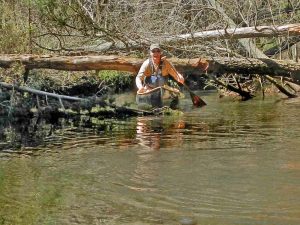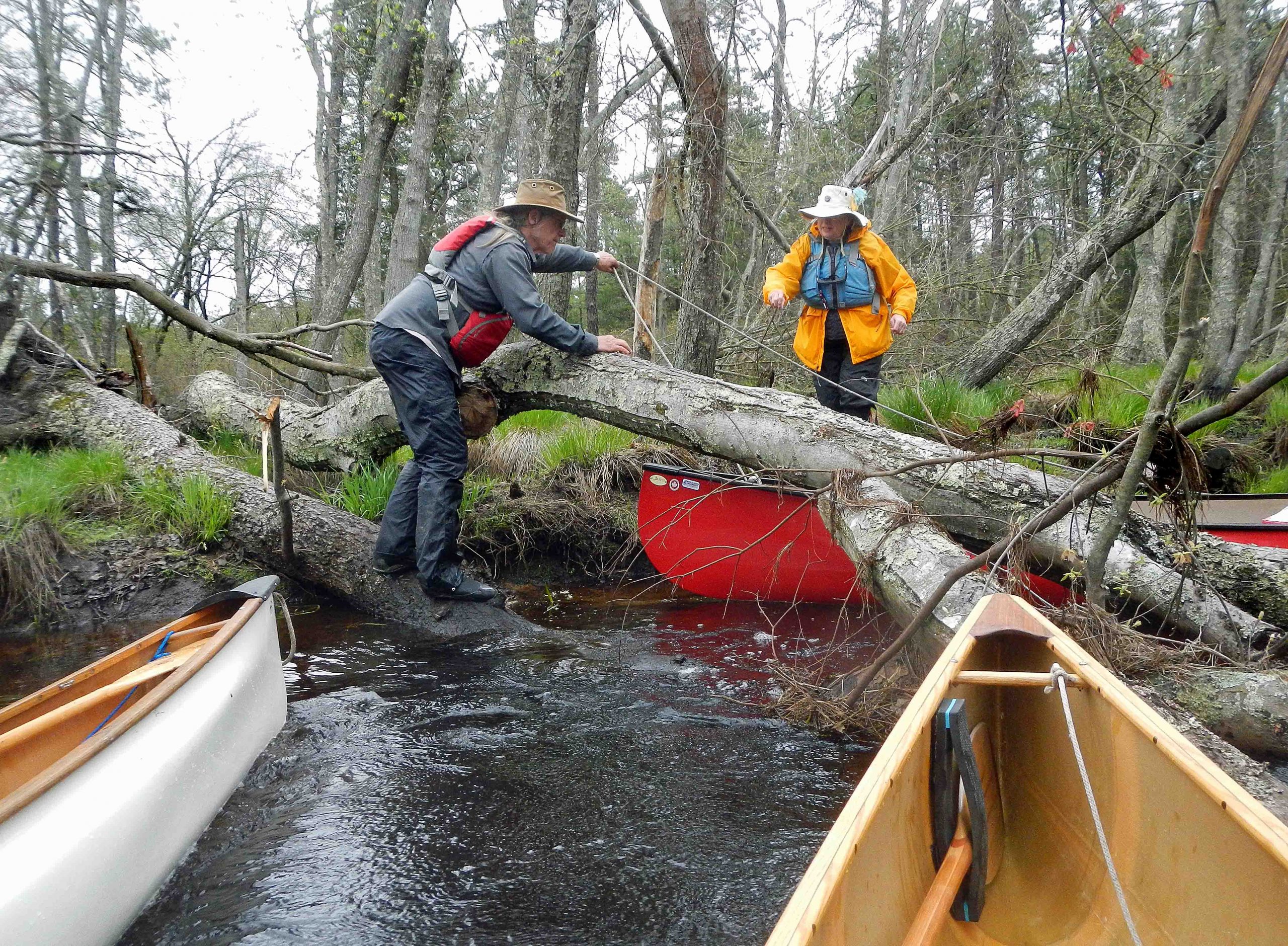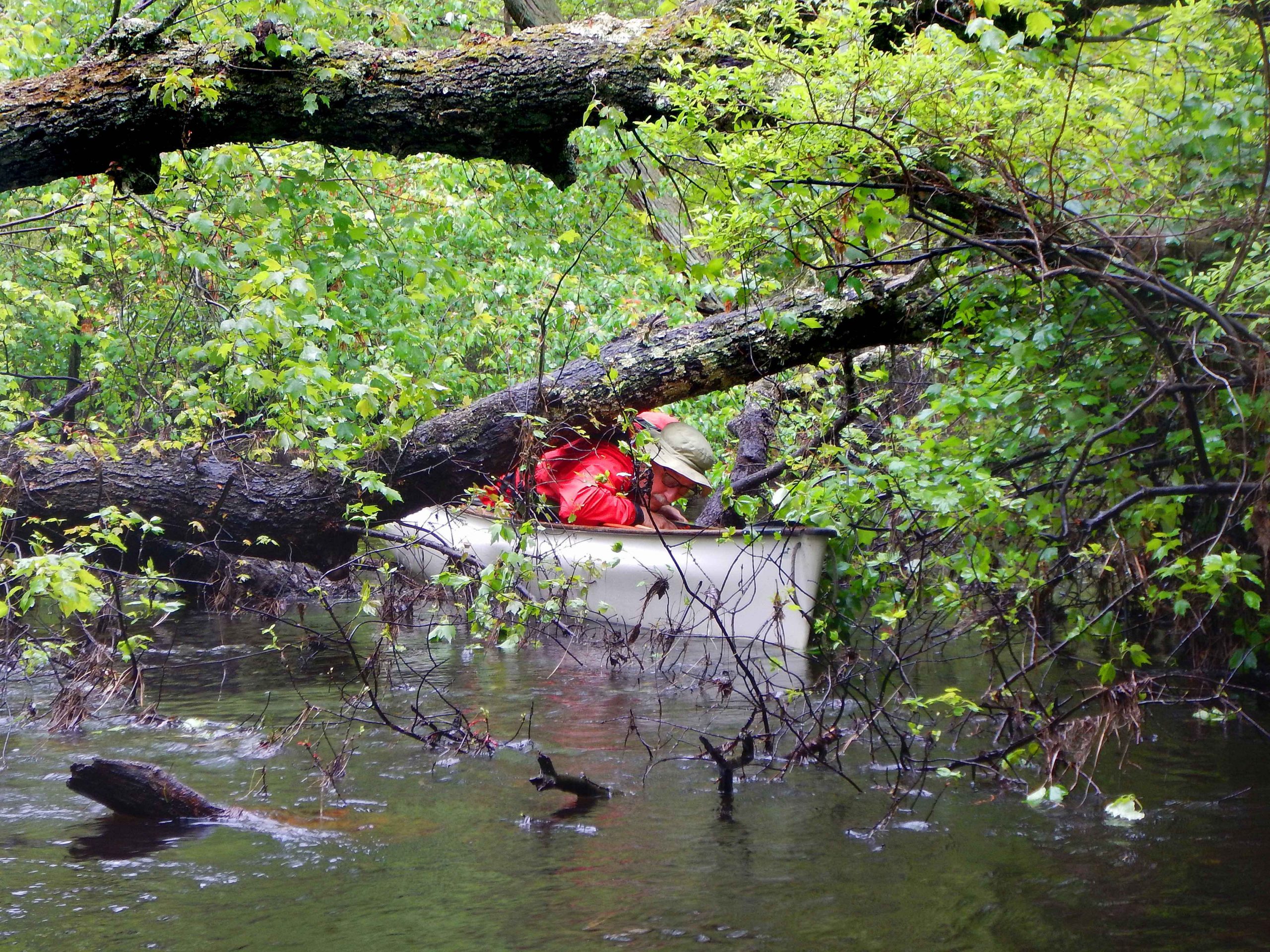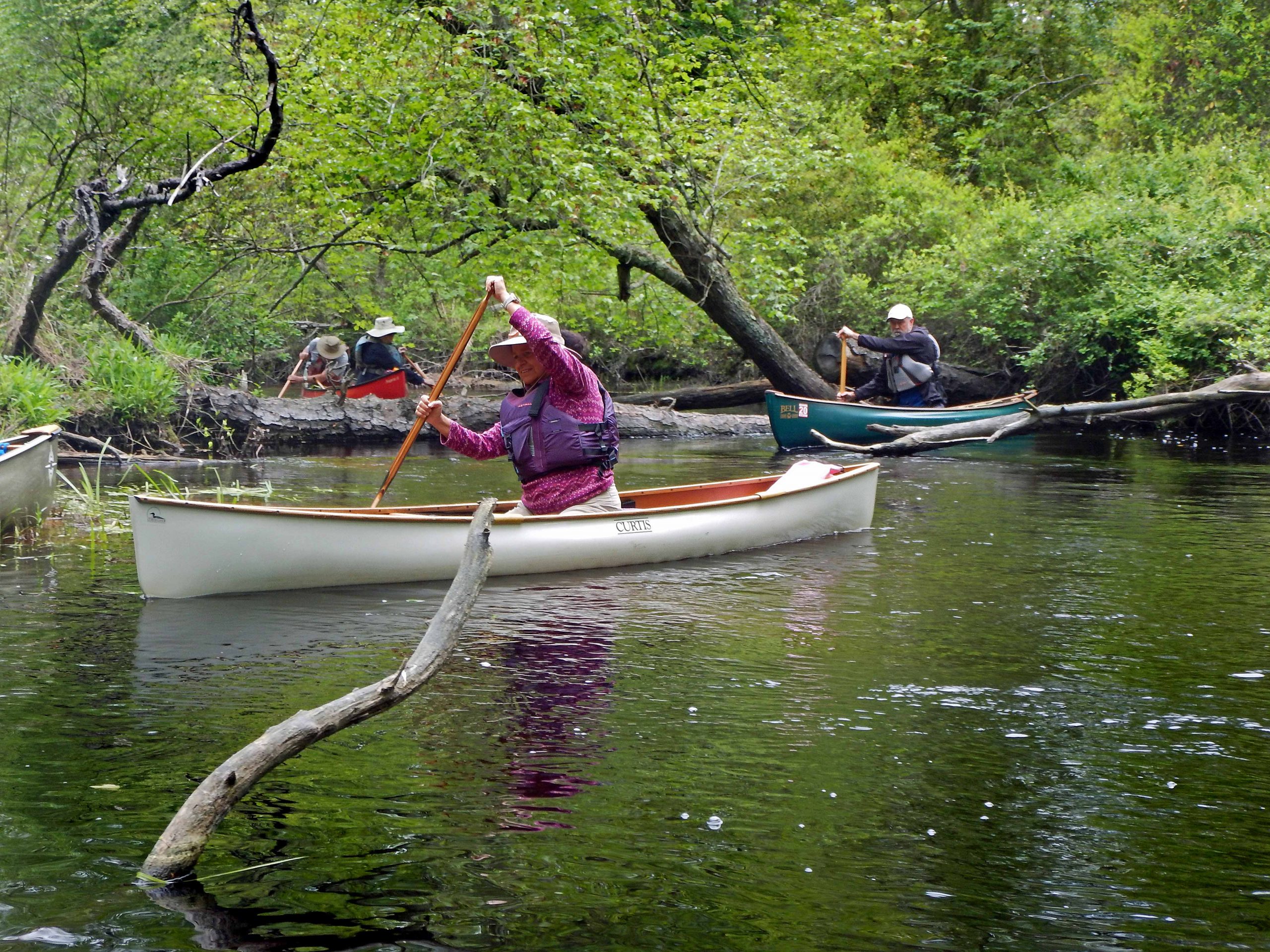AKA Bushwacking by Canoe
I love paddling narrow, twisting, streams. You know the kind – small little meandering water threads with modest current cutting deep through the woodlands going who knows where. Such as you might find with some of the tiny rivers in the Jersey Pinelands, or on twisty little passages between lakes and ponds in the Adirondacks for instance, or some obscure spring outflows in Florida and elsewhere. Too small and maybe too “obstructed” for lots of paddlers, but to those with the skills and the spirit of exploration and adventure (“let’s go see what’s out there, and see if we can get through”) such streams can make for a worthwhile day of interesting paddling. But it’s different. It can be a whole lot like bushwhacking on foot, and bushwhacking by canoe can be a whole lot of fun.
This is not everyone’s cup of tea and there are some extra precautions to be taken. Folks without refined paddling skills and the necessary judgement to evaluate the hazards would be advised to stay clear of such situations. Most of these “fun” elements fall under the broad category of strainers which we generally advise paddlers to stay away from but if approached properly can add a creative twist to their experience. They are also an opportunity to practice and refine skills which may come in handy when a surprise strainer pops up, unexpectedly.
Paddling such streams is like navigating an obstacle course. It requires the ability to “read” not only the water but to evaluate each and every obstacle. Such an evaluation goes something like this.
- Is there a safe route over, under, through or around the obstacle? If not, it’s time to portage.
- Are my skills up to the task? If not, it’s time to portage.
- What is a reasonable, worst-case scenario and am I willing to take that risk? If not, it’s time to portage.
Let’s explore each of these items.
- Some obstacles simply cannot be navigated with any reasonable degree of safety. The pile of trees and branches may be too massive with no path around or through it. Climbing over it may not be safe due to instability of the debris or slippery surfaces. Perhaps it’s a classic strainer where the current is so strong that there is a severe risk of pinning the canoe or worse yet, getting yourself trapped. There is no shame in going to shore and taking your canoe for a walk in the woods.
- There may be a potential paddling path but do I have the skills to navigate it? Am I able to make the necessary, tight turns? Am I able to duck low enough in the canoe to pass under the overhanging tree limbs while still maintaining control of the boat? Can I safely climb onto the downed log, pull my canoe over it and get back in? A couple of years ago, paddling in the New Jersey Pine Barrens, there was a particularly long and congested section where it was necessary to do something akin to a K turn, simultaneously ducking beneath overhead branches in the midst of a swift current. “Worse,” directly below this jumble was another and another each containing similar challenges. Every one in the group was prepared, both mentally and with the necessary skills. All made it through successfully.
- There is always the risk of a mishap. A worst-case mishap could be fatal. Most mishaps are inconvenient, perhaps uncomfortable and possibly expensive. A slip and resulting fall into the water might mean being wet and cold for the rest of the trip, or not if you’re wearing a dry suit or carrying a change of clothes. A pinned and damaged boat could be costly. Even non-fatal injuries could mess up your paddling season or worse. Don’t forget about your paddling partners. Whatever happens to you, will have consequences for them as well.
Pick your paddling partners carefully. An ill prepared member of the group puts the entire group at risk. It’s ok to bring along a less experienced paddler, but they may need some additional guidance and must be willing to accept it. What may be an acceptable challenge for one member of the group, may not be so for others. Generally, one member of the party should not enter a challenging spot until the paddler ahead is in the clear. (SOS) Single file, one at a time and well-spaced is the mantra.
I generally carry a few “key” pieces of equipment when paddling such streams.
- Bow and stern lines are mandatory. The lines should each be approximately the length of the canoe. Such lines will help you
 control the canoe should you need to disembark and or reenter from a challenging spot. With them, you’ll have the option of lining and they’re handy for tying up the canoe at lunch, when there isn’t room to pull it out. The lines should arranged in the canoe so that you can reach them from the paddling station. If they are coiled at the bow and stern, unreachable from the seat area, they will be of minimal value.
control the canoe should you need to disembark and or reenter from a challenging spot. With them, you’ll have the option of lining and they’re handy for tying up the canoe at lunch, when there isn’t room to pull it out. The lines should arranged in the canoe so that you can reach them from the paddling station. If they are coiled at the bow and stern, unreachable from the seat area, they will be of minimal value. - A ditch bag. This is a dry bag, filled with a change of clothes and perhaps a towel. It must be secured in the boat so that it isn’t lost in the event of a capsize.
- A sharp pruning saw and or tree pruning shears should be part of your kit. Often, trimming or clipping some small branches may make the difference between a safe run and one risking entanglement. I prefer to remove only that which is necessary for safety and no more.
 Let’s begin with a single tree trunk or large limb, spanning the creek. It has many branches, some pointing down into the water. The bottom of most of the main trunk is very close to the water surface but there is a short section with about 18” of “headroom” between the bottom of the trunk and the water surface. The water is flowing at a moderate pace but you are certain that you can approach it and back off if necessary. Your evaluation reveals no strainers downstream from the tree and a runnable route to line up with the “slot”. The only issue is your ability to duck low enough while not losing directional control. With such a “duck-under” situation, one needs to remember that their life jacket adds a couple of inches of height to their back. Many a paddler has gotten caught or jammed up that way. My usual technique is to line up, get some momentum pointing my canoe in the right direction, then quickly slide off my seat, into the bilge of the canoe, usually on my side. In this manner I can get almost completely beneath the gunwales. As soon as I am clear of the log, I can easily and quickly roll onto my knees and return to paddling. Most of my solo canoes have the forward thwart at least 36” ahead of the seat, giving me plenty of room to duck into.
Let’s begin with a single tree trunk or large limb, spanning the creek. It has many branches, some pointing down into the water. The bottom of most of the main trunk is very close to the water surface but there is a short section with about 18” of “headroom” between the bottom of the trunk and the water surface. The water is flowing at a moderate pace but you are certain that you can approach it and back off if necessary. Your evaluation reveals no strainers downstream from the tree and a runnable route to line up with the “slot”. The only issue is your ability to duck low enough while not losing directional control. With such a “duck-under” situation, one needs to remember that their life jacket adds a couple of inches of height to their back. Many a paddler has gotten caught or jammed up that way. My usual technique is to line up, get some momentum pointing my canoe in the right direction, then quickly slide off my seat, into the bilge of the canoe, usually on my side. In this manner I can get almost completely beneath the gunwales. As soon as I am clear of the log, I can easily and quickly roll onto my knees and return to paddling. Most of my solo canoes have the forward thwart at least 36” ahead of the seat, giving me plenty of room to duck into.
Let’s say that you come upon a log that is partially submerged. Most if not all of the water is flowing beneath it. You’ve evaluated the situation from a safe distance and determined that paddling up to it is safe. What are your options? One possibility it to disembark onto the log, pull or lift your canoe over and reenter. Hazards might include the log being slippery or hard to balance on. Maybe it’s got poison ivy growing on it. Another option would be the teeter-totter method. To see-saw over a log one gets upstream (assuming you are approaching from that direction) a few canoe lengths from the intended crossing spot. The canoe is aligned so that it will approach the intended crossing spot at a right angle or close to it. The paddler then “hops” behind the seat, positioning him/herself as close to the stern as possible. The bow is now high in the air. (Beware that the canoe will be very tippy from this position.) The paddler then paddles forward, riding the bow up and over the log as far as possible. To be successful, the canoe will need to be approximately half way over the log before it grounds out. The paddler them climbs back over the seat (and possibly over the front thwart” until the canoe “teeter-totters” forward. Finally, he/she takes a couple of forward strokes, dragging the canoe free of the log before returning to the usual paddling station. A word of WARNING! Not all canoes can take the stress of being teeter-tottered. I have known paddlers to crack the bottoms of their canoes while doing such a maneuver. None the less, if you are confident in your skills and your boat, it’s a quick way over a common obstacle.
Zig zagging through a maze of downed tree limbs is perhaps the most common scenario. To be successful, in a tight maze, one needs to be proficient in the use of wedges, cross wedges, axles, cross axles, side slips, draws, etcetera. Sweeps, reverse sweeps and J strokes alone are not likely to be sufficient. One generally doesn’t get much time to ponder the next move. The necessary maneuvers need to be instinctual and one must always be looking one step ahead. A safe paddler will evaluate such a maze before entering it. Deciding, half way through, that you’ve bitten off more than you can chew, is a bad place to be.
to be proficient in the use of wedges, cross wedges, axles, cross axles, side slips, draws, etcetera. Sweeps, reverse sweeps and J strokes alone are not likely to be sufficient. One generally doesn’t get much time to ponder the next move. The necessary maneuvers need to be instinctual and one must always be looking one step ahead. A safe paddler will evaluate such a maze before entering it. Deciding, half way through, that you’ve bitten off more than you can chew, is a bad place to be.
Paddling downstream, with the current pushing you along, is by far, the most common scenario. Paddling upstream adds additional challenges but significantly reduces risks. If one approaches a strainer or other obstruction from the downstream side and doesn’t like what they see, there is no risk of being pushed into it. Because of this “built in” safety factor, exploring from the downstream side is my preferred method when scouting an unfamiliar stream. When I’ve had enough of the game, I can simply backtrack, now knowing what challenges lie ahead.
Tree Dimensional paddling is an opportunity to test and develop your skills, each time you go out. It’s expecting and planning for the unexpected. It is about learning how to deal safely with challenges that may arise whenever paddling narrow, twisty streams. It’s not for everyone but is it for you?
Marc Ornstein
Credit to Bruce Kemp for his insight, suggestions and edits.
VIDEOS:
https://www.youtube.com/watch?v=-xpkibUY1X4
https://www.youtube.com/watch?v=drM58OgHxO0&t=1s